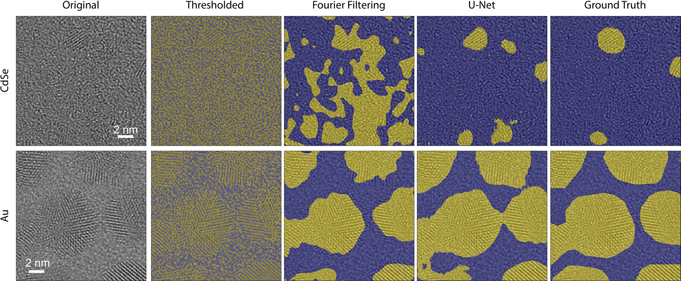Crossref Citations
This article has been cited by the following publications. This list is generated based on data provided by
Crossref.
Nguyen, Tri N. M.
Guo, Yichen
Qin, Shuyu
Frew, Kylie S.
Xu, Ruijuan
and
Agar, Joshua C.
2021.
Symmetry-aware recursive image similarity exploration for materials microscopy.
npj Computational Materials,
Vol. 7,
Issue. 1,
Sytwu, Katherine
Rangel DaCosta, Luis
Groschner, Catherine
and
Scott, Mary C
2022.
Maximizing Neural Net Generalizability and Transfer Learning Success for Transmission Electron Microscopy Image Analysis in the Face of Small Experimental Datasets.
Microscopy and Microanalysis,
Vol. 28,
Issue. S1,
p.
3124.
Lewis, Nicholas R.
Jin, Yicheng
Tang, Xiuyu
Shah, Vidit
Doty, Christina
Matthews, Bethany E.
Akers, Sarah
and
Spurgeon, Steven R.
2022.
Forecasting of in situ electron energy loss spectroscopy.
npj Computational Materials,
Vol. 8,
Issue. 1,
Alrfou, Khaled
Kordijazi, Amir
Rohatgi, Pradeep
and
Zhao, Tian
2022.
Synergy of unsupervised and supervised machine learning methods for the segmentation of the graphite particles in the microstructure of ductile iron.
Materials Today Communications,
Vol. 30,
Issue. ,
p.
103174.
Moreno-Hernandez, Ivan A.
Crook, Michelle F.
Jamali, Vida
and
Alivisatos, A. Paul
2022.
Recent advances in the study of colloidal nanocrystals enabled by in situ liquid-phase transmission electron microscopy.
MRS Bulletin,
Vol. 47,
Issue. 3,
p.
305.
Jacobs, Ryan
2022.
Deep learning object detection in materials science: Current state and future directions.
Computational Materials Science,
Vol. 211,
Issue. ,
p.
111527.
Sytwu, Katherine
Groschner, Catherine
and
Scott, Mary C
2022.
Understanding the Influence of Receptive Field and Network Complexity in Neural Network-Guided TEM Image Analysis.
Microscopy and Microanalysis,
Vol. 28,
Issue. 6,
p.
1896.
Rickert, Carolin A.
and
Lieleg, Oliver
2022.
Machine learning approaches for biomolecular, biophysical, and biomaterials research.
Biophysics Reviews,
Vol. 3,
Issue. 2,
Basak, Shibabrata
Dzieciol, Krzysztof
Durmus, Yasin Emre
Tempel, Hermann
Kungl, Hans
George, Chandramohan
Mayer, Joachim
and
Eichel, Rüdiger-A.
2022.
Characterizing battery materials and electrodes via in situ/operando transmission electron microscopy.
Chemical Physics Reviews,
Vol. 3,
Issue. 3,
Bell, Cameron G.
Treder, Kevin P.
Kim, Judy S.
Schuster, Manfred E.
Kirkland, Angus I.
and
Slater, Thomas J. A.
2022.
Trainable segmentation for transmission electron microscope images of inorganic nanoparticles.
Journal of Microscopy,
Vol. 288,
Issue. 3,
p.
169.
Lu, Shizhao
Montz, Brian
Emrick, Todd
and
Jayaraman, Arthi
2022.
Semi-supervised machine learning workflow for analysis of nanowire morphologies from transmission electron microscopy images.
Digital Discovery,
Vol. 1,
Issue. 6,
p.
816.
Bruefach, Alexandra
Ophus, Colin
and
Scott, Mary C
2022.
Analysis of Interpretable Data Representations for 4D-STEM Using Unsupervised Learning.
Microscopy and Microanalysis,
Vol. 28,
Issue. 6,
p.
1998.
2022.
Principles of Electron Optics, Volume 4.
p.
2489.
Williamson, Emily M.
Ghrist, Aaron M.
Karadaghi, Lanja R.
Smock, Sara R.
Barim, Gözde
and
Brutchey, Richard L.
2022.
Creating ground truth for nanocrystal morphology: a fully automated pipeline for unbiased transmission electron microscopy analysis.
Nanoscale,
Vol. 14,
Issue. 41,
p.
15327.
Zhu, Xiaoyang
Li, Yan
and
Gu, Ning
2023.
Application of Artificial Intelligence in the Exploration and Optimization of Biomedical Nanomaterials.
Nano Biomedicine and Engineering,
Vol. 15,
Issue. 3,
p.
342.
Gumbiowski, Nina
Loza, Kateryna
Heggen, Marc
and
Epple, Matthias
2023.
Automated analysis of transmission electron micrographs of metallic nanoparticles by machine learning.
Nanoscale Advances,
Vol. 5,
Issue. 8,
p.
2318.
2023.
In‐Situ Transmission Electron Microscopy Experiments.
p.
285.
Smith, Jacob
Wang, Sihan
Eldred, Tim B.
DellaRova, Cierra
and
Gao, Wenpei
2023.
Encyclopedia of Nanomaterials.
p.
123.
Kaphle, Amrit
Jayarathna, Sandun
Moktan, Hem
Aliru, Maureen
Raghuram, Subhiksha
Krishnan, Sunil
and
Cho, Sang Hyun
2023.
Deep Learning-Based TEM Image Analysis for Fully Automated Detection of Gold Nanoparticles Internalized Within Tumor Cell.
Microscopy and Microanalysis,
Vol. 29,
Issue. 4,
p.
1474.
Treder, Kevin P.
Huang, Chen
Bell, Cameron G.
Slater, Thomas J. A.
Schuster, Manfred E.
Özkaya, Doğan
Kim, Judy S.
and
Kirkland, Angus I.
2023.
nNPipe: a neural network pipeline for automated analysis of morphologically diverse catalyst systems.
npj Computational Materials,
Vol. 9,
Issue. 1,






